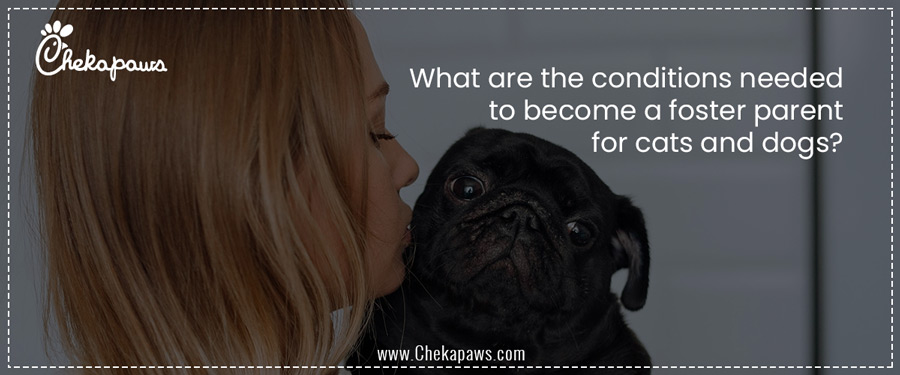Although the requirements for becoming a foster parent for dogs and cats differ from organization to organization, Fostering, however, requires dedication and fulfilling requirements set by shelters, rescue groups, and legal bodies. The fundamental criteria and factors to be taken into consideration while adopting cats and dogs are described in this post below the following are the conditions needed to become a foster parent for cats and dogs:

Table of Contents
Basic Requirements:
Age Requirement – Foster parents must be at least 18 years old to be accepted into most shelters and rescues. Some organizations, on the other hand, have stricter rules, requiring foster parents to be at least 21 years old, and in certain situations, even older. The purpose of this age requirement is to make sure that people are mature, financially secure, and responsible enough to take care of a foster pet.
Consistent Living Conditions– Regardless of whether you own or rent, your home should be stable. If you rent, your landlord may need to give you written consent before you may bring the dog or cat you are fostering into your home.
Time Commitment – It takes patience and time to foster dogs and cats since they may require medical attention, training, or socialization so it requires patience and time.
Safe Environment – Your house needs to be pet-proofed, meaning it must be free of harmful items, poisonous plants, and ways for pets to escape. Remove off anything that your foster animal might chew on, such as clothing, garbage. Before bringing the foster pet home, make sure all doors, cabinets, and trash cans are secure. If you have any small animals, keep them in safe cages or aquariums.
Transportation – For emergencies, adoption events, and veterinary visits, you should have access to dependable transportation.
Separate Space (if needed) – Certain animals, particularly those that are ill or unvaccinated, require a calm, private area (such as a spare room) away from other pets.
Other Pets (if applicable) – All of your pets should be vaccinated and able to put up with a new foster animal.
Experience with animals: While not necessarily necessary, prior experience with pet care, especially with dogs and cats, is generally appreciated.
Commitment to Guidelines –Fosters have to adhere to the feeding, training, and medical protocols of the majority of rescues.
What Are the Options for Fostering As a Minor?
Although they might not be able to foster dogs on their own legally, minors can nevertheless participate in the following ways:
Fostering with a Parent or Guardian: A parent or guardian may officially take on the role of foster parent in some organisations.
Teens can frequently volunteer at shelters by interacting with animals, cleaning kennels, or walking dogs.
Supporting Foster Families: With adult supervision, minors can assist in taking care of a foster pet in their home.
Foster-to-Adoption Arrangements: Prior to adoption, some organizations permit younger people to begin as co-foster under the guidance of their parents.
Special Cases:
Sick or Injured Animals
Foster pet parents help shelters manage overcrowding, offer special care to animals recovering from medical conditions, and provide socialization to increase their chances of adoption. Certain foster animals can need rehabilitation, isolation, or medical attention. Keep an eye out for signs of an illness, such as shifts in energy, appetite, and behavior.
Ensure that the animal has a hygienic and comfy spot to sleep.
Newborn Kittens/Puppies
These tiny pets may require constant bottle feeding. Some shelters and rescue organizations have experienced volunteers who have received specialized training to work with bottle babies—kittens or puppies under four weeks old that require bottle feeding every two to six hours. For those who are caring for newborn kittens or newborn puppies for the first time, many additionally furthermore provide instruction, training.
Behavioral Issues
Before they are prepared for adoption, some pets require socialization and training. As Taking in a dog from a shelter or rescue group that shows behavioral issues like aggression, anxiety, destructiveness, excessive barking, or separation anxiety, and requiring the foster parent to manage and work on correcting these issues through positive reinforcement training is known as “fostering behavioral issues in dogs. Successfully fostering a dog with behavioral issues requires a lot of patience, consistency in training methods, and a calm approach to help the dog feel secure.
Application Process:
During the application process, you can be asked specific questions like: Do you currently own any pets? If so, what are the breeds and ages of your pets?
What is your background in animal care? Which kinds of animals would you like to foster?
How much time are you able to commit to taking care of a foster pet?
Do you feel at ease around animals that may exhibit behavioral problems?
Fill out an application – This could involve enquiries concerning your residence, routine, and background.
Home Visit or Virtual Interview – To ensure a secure setting, some rescues perform home inspections.
Training Session –Foster training for dogs and cats is offered by some organizations to teach you about behavior, medical requirements, and care.
Approval & Matching –Based on your background and living circumstances, the rescue will match you with a foster pet when you are accepted.
Home Environment Requirements
A home that is both pet-friendly and safe is important. Among the basic criteria are:
Secure Living Space: To keep cats from escaping, a secure indoor space is ideal, or a fenced yard for dogs.
Separate Area for New Fosters: Certain organizations need a distinct area to keep foster animals apart from resident animals, particularly while they are being introduced.
A clean and safe environment is one that is devoid of potential dangers like exposed electrical cords, small objects, or poisonous plants.
Pet-proofing includes removing dangerous chemicals, locking up garbage cans, and sealing off any escape routes.
Contractual and Legal Responsibilities
Foster parents are frequently asked to sign a contract detailing their duties, which may include:
Returning the Pet for Adoption Events: Commitment to the meet-and-greet procedures set forth by the shelter.
No Unauthorized Rehoming: If a foster pet is unable to continue receiving care, they must be returned to the organization.
Liability Clauses: Being aware of any responsibilities under the law relating to harm or property damage brought on by the foster pet.
Emotional Considerations
It can be emotionally draining to foster pets, especially when it comes time to say goodbye. Foster parents should do the following:
Get Ready for Attachment: Recognize that fostering is a temporary situation that is a necessary step on the pet’s journey to finding a permanent home.
Be Aware of Special Needs Cases: Certain animals need more patience, care, and healing.
Have a Support System: Seeking emotional support from friends or foster networks might be beneficial.
Conclusion
Helping animals in need can be fulfilled in a meaningful way by becoming a foster parent for dogs and cats. Fosters play an important part in the rescue community by providing a loving home, meeting basic needs, and being ready for every challenge. To start the foster adoption procedure, get in touch with nearby shelters and rescue organizations.








Nice